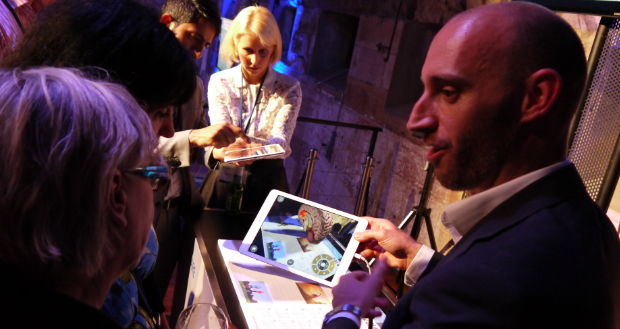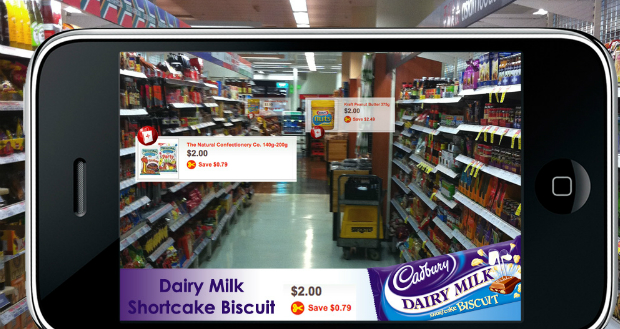
The country’s third biggest printer Blue Star is booting up its new augmented reality division, with the company being told it will ‘supercharge’ its print business. The Blue Star Interactive division was launched this week, with printers and marketing agency reps flocking to a demonstration of the technology in Sydney which showed off the power of print in tandem with digital media. On display were a range of AR possibilities for advertisers – from cruise ship brochures offering inside-views of cabins, a virtual car test drive, to an interactive instruction manual showing how to put together a barbeque step-by-step. Using an iPad, or similar digital device – and focusing on printed images as the trigger – videos, 3D models or other digital content spring to life on the screen, like a QR code but less clunky.

Gavin Meredith, business development manager with Blue Star DM (r), walks visitors through a demo app designed to help doctors show patients the exact effects a quit-smoking drug will have on their brain
Blue Star boss Geoff Selig says print has a major part to play in the augmented reality world – serving as the physical anchor to campaigns that spring into cyberspace. He tells Australian Printer, “This technology leverages off recognising a printed image. The image is the gateway to the augmented reality experience, it can take your audience directly to wherever you’d like them to go. “It doesn’t have to be a brochure, it can work with any printed medium; a poster, point of sale, billboard or For Sale sign in front of a house. “I think this reinforces the power of emerging technologies working in tandem with traditional technologies like print, particularly in the direct mail space in terms of big data and personalised targeted one-to-one communications. We are at the beginning of the journey in this space, it is not going to go away, and print is very much a part of the mix.” David Francis, AR entrepreneur and a print man at heart – having grown up in a print shop – is heading up the Blue Star Interactive division, which will be based in Australia and draft in technical expertise from around the world where necessary. Francis says one of the key strengths of AR as an advertising medium is its ability to measure viewing numbers and collect data in real time for advertisers. He tells AP, “Augmented reality connects print, mobile, social media, branded rich media content, games and big data in a highly measurable and accountable way. Our Blue Star AR interactions are about setting products and services in context, in your world. It’s about reducing friction and creating the shortest distance between intention and action, allowing customers to explore what they want to know without having to navigate through websites.
“This isn’t about flashing your brand up in someone’s vicinity and calling it an impression or an eyeball. Through this medium not only can you see and hear a product but you can interact with it, see it from any angle and engage your sense of the world around you – that’s how memories are made. It’s about becoming more contextually relevant to your consumer, interacting with them in their world and inviting them to opt in and meet you half way.” Dave Lorenzini, founder of Glassware Foundry – app developer for Google Glass – and former Google Earth director, was also in town to kick off the launch. He says AR will not cannibalise Blue Star’s print business, but ‘supercharge’ it. He tells AP, “Blue Star has shown that the printed page can be a lot more than meets the eye. With personalisation, targeting people and moving them to action, you can have a really effective medium. We are going to see more adoption of this technology once the business impact on the back end kicks in. AR is not just for fun, it’s good for business – tracking the results will prove to the brands that it is effective. “We are seeing a new era of effortless interaction with technology. For print the impact is incredible. With AR on one page you can get 100 things for 100 people – translation into different languages, tailored content or a tutorial on your first visit. You can design ways to entertain your customer, then help them easily share what they have seen, or click for more info, or subscribe – all from the one printed page. There is an amazing world coming. Print is going to persist as far as I can see.”
Comment below to have your say on this story.
If you have a news story or tip-off, get in touch at editorial@sprinter.com.au.
Sign up to the Sprinter newsletter




